Lavash (Armenian Flatbread)
Lavash is a traditional Armenian flatbread that is delicious, versatile, and easy to make at home. This scrumptious bread is soft and pliable enough for wraps yet sturdy enough to dip into stews. Plus, it is made with only 5 simple ingredients!

Lavash is a simple dish with major staying power. This time-honored traditional flatbread is temptingly thin and crispy while remaining soft, flexible, and foldable. It is easy to understand why this Middle Eastern gem has been around for thousands of years!
This Armenian flatbread recipe is simple and straightforward to make. In fact, the only necessary ingredients are flour, yeast, oil, salt, and water. However, it does require some time and patience. Have faith and resist the temptation to skip or rush through any steps! I also highly recommend a stand mixer. It isn’t absolutely necessary but will make your life much easier.

Table of Contents
For more homemade flatbread recipes, check out my Roti, Barbari, or Zaatar Bread.

- Flour – Any standard, all-purpose flour will do the trick. For the best flavor, I prefer unbleached and not bromated.
- Instant Yeast – Helps the dough rise and gives the bread those lovely, airy bubbles.
- Vegetable Oil – Adds moisture, richness, and pliability to the dough.
- Kosher Salt – Enhances and harmonizes the natural flavors of the dough.
- Sesame Seeds – (Optional) Add a light nutty flavor and a delicate crunch.

- Make the Old Dough. Combine the flour, water, and yeast in a large bowl and mix with a rubber spatula until a thick paste forms. Transfer the paste to a small, oiled container and set aside to rise for about 1 ½ to 2 hours, or in the fridge overnight. You want the old dough to double in volume. If you chill the dough overnight, let it come to room temperature for at least 2 hours before proceeding.
- Start the Fresh Dough. Transfer the old dough to a stand mixer along with the water, oil, and kosher salt. Use your hands to squish and break up the old dough in the water.
- Add Flour. Fit your mixer with the paddle attachment. Add one cup of flour and mix on low until the dough resembles pancake batter. Add the remaining flour and continue to mix on low until fully incorporated. Use a kitchen towel to cover the bowl. Set it aside for about 20 minutes, allowing time for the flour to hydrate.
- Smooth the Dough. Replace the paddle with the dough hook attachment. Remove the towel, return the bowl to the mixer, and mix on medium for about 4 minutes. You want the dough to appear smooth and to no longer be sticking to the sides of the bowl.

- Rest. Transfer the dough to a lightly oiled bowl with an 8-cup capacity, cover with plastic wrap, and set aside for 3 hours or overnight in the fridge.
- Rise. Just like with the old dough, make sure that it has doubled in size and is at room temperature before continuing.
- Divide the Dough. Move the dough to a flat, clean, lightly floured area and divide it into 8 roughly equal pieces. They should weigh about 3.5 ounces each.

- Shape into Balls. Use a circular motion on the counter to form the dough into balls. Transfer to a lightly oiled baking sheet, making sure they aren’t touching, then cover them with a lightly oiled piece of plastic wrap and set aside to rest for at least an hour.
- Roll Flat. Lightly dust a clean surface and rolling pin with flour. Work with one piece of dough at a time, keeping the rest covered and moist. Roll each one out into a rectangular shape. If desired, use the rolling pin to incorporate some sesame seeds into the dough.
- Heat the Pan. Heat a large cast iron skillet or griddle over medium-high heat until a drop of water instantly evaporates.
- Cook the Lavash. Add the flatbread to the hot skillet and let it blister and brown for about one minute. Carefully flip it over with tongs and brown the other side for no more than 30 seconds. If you want browner bread, flip it over and cook for another 30 seconds on the first side. Place each cooked flatbread under a kitchen towel while you repeat with the rest of the dough. Serve warm.
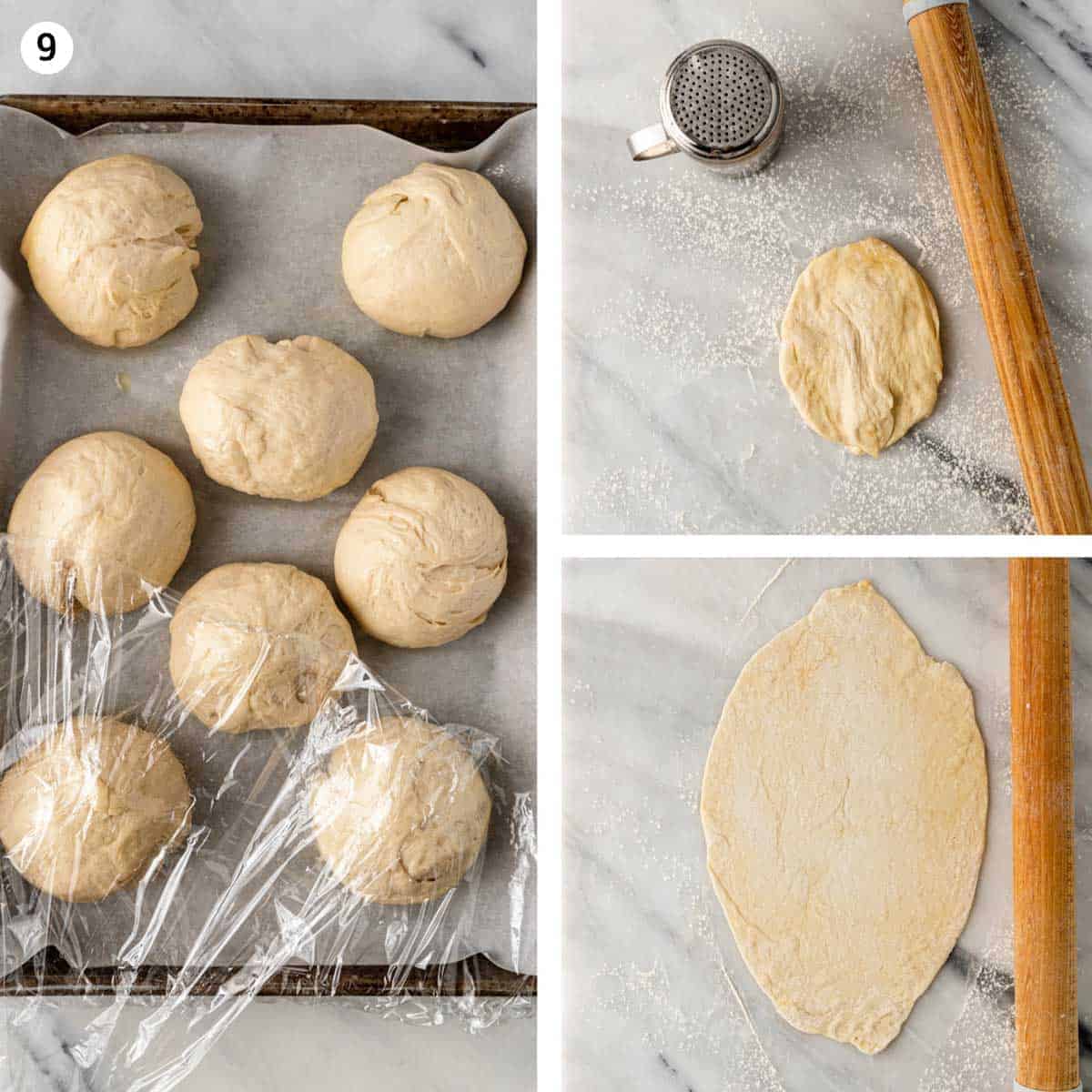
Storing Lavash
Eat the lavash soon after making it or store it in plastic bags to keep the bread pliable once cooled. It’s okay if it dries out and turns brittle; rehydrate it by misting the lavash with water and covering it with a towel to let it soften. Soon after, it should be pliable enough to roll up without cracking. If it’s still cracking, mist with more water.
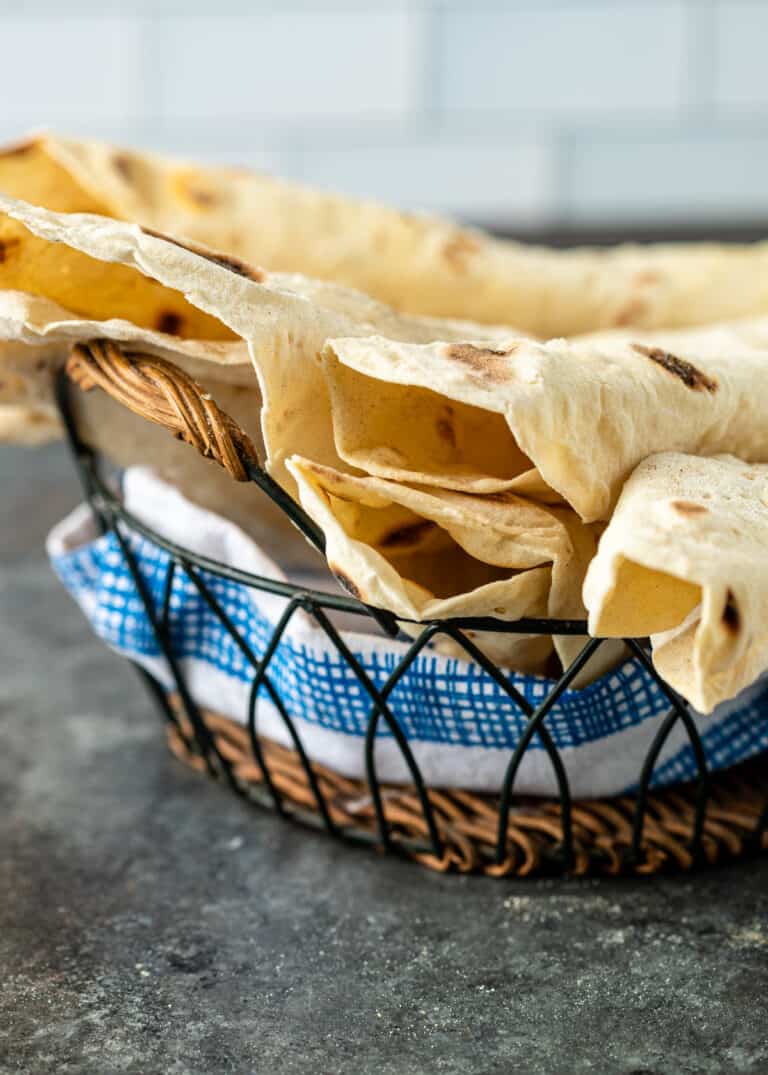
For the best results, you want to roll the dough out quite thin. This will make the lavash flatbread more pliable and give it more of those big airy bubbles. Aim for about ⅛ inch or even a little thinner.
Yes! Once the dough has been divided and shaped into balls, you can choose to cover it with plastic wrap and store it in the refrigerator for up to 3 days.
Then, when it is time to make the lavash flatbread, all you will need to do is roll it out and cook it.
Here are just a few of the countless ways to enjoy this soft and thin flatbread:
– Wrapped around roasted meats like Grilled Koobideh, Lamb Shawarma, or Chicken Kofta.
– Dipped into Mutabal, White Bean Hummus, Whipped Feta, or any of your favorite dips.
– Stuffed with Baba Ganoush, Tabouli Salad, and Falafel for a quick vegetarian lunch.
– Served alongside hearty stews like Lamb Tagine or this Moroccan Chicken Stew.
Share this recipe on Pinterest!
Love this recipe? Share it with the world on Pinterest.
Subscribe to my Newsletter, follow me on Facebook, Pinterest, Instagram and YouTube for all my latest recipes and videos.
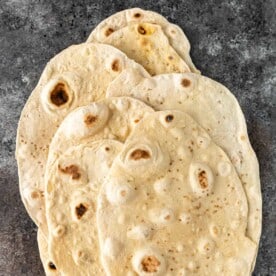
Lavash (Armenian Flatbread)
Ingredients
Old Dough
- 70 g all-purpose flour (1/2 cup)
- 70 ml lukewarm water (1/4 cup plus a scant 1 tbsp)
- ¼ tsp instant yeast
Dough
- 240 ml lukewarm water (1 cup)
- 1 tbsp vegetable oil
- 2 tsp kosher salt
- 440 g all-purpose flour, plus more for dusting (3 cups plus 2 Tbsp)
Instructions
Old Dough
- Using a rubber spatula, mix together the flour, water, and yeast in a bowl until it forms a thick paste. Scrape the paste into a small, lightly oiled container, cover, and let it sit out for 1½ to 2 hours (See Note 1). Old dough should have doubled in volume.
Dough
- In the bowl of a stand mixer, combine the old dough, water, oil, and salt. Squish the old dough with your hands to break it up in the water.
- Add 1 cup of the flour and using the paddle attachment, mix on low speed until the dough looks like pancake batter. Next add the remaining flour and mix on low speed until fully incorporated. Cover the bowl with a kitchen towel and let the dough sit for 20 minutes (See Note 2).
- Remove towel, attach the dough hook to the stand mixer and mix the dough on medium speed until the dough releases from the sides of the bowl without sticking and feels smooth to the touch, about 4 minutes.
- Lightly grease an 8 cup bowl and place the dough inside. Cover the bowl with plastic wrap, and let it rest for 3 hours or until doubled in volume (See Note 3).
- Dust a clean surface lightly with flour and place the dough on top. Cut the dough into 8 pieces about 3.5 ounces each.
Shape the dough
- Cup the palm of your hand over one portion at a time and move your hand in a circle. The friction from the counter will help form the dough into a ball.
- Lightly oil a rimmed tray and place the dough on the tray, don’t let dough balls touch. Cover with plastic wrap lightly coated with cooking spray or oil. Let rest for 1 hour (See Note 4).
- Dust a clean surface lightly with flour. Lightly flour a rolling pin and roll each ball of dough into a thin rectangle about 8×12 inches. Work in batches and keep dough covered in between. OPTIONAL: once dough is rolled out, sprinkle sesame seeds on one side, and with rolling pin, press seeds into dough. These doesn’t have to look perfect.
Cook the Lavash
- Place a large cast-iron pan (or griddle over two burners) over medium-high heat for a few minutes or until a sprinkle of water instantly evaporates.
- Place the dough in the pan or over the griddle. Cook for 1 minute or until puffed slightly and blistered. Turn over using tongs to cook the other side, no more than 30 seconds. For extra browning, flip it over for 30 more seconds.
- Transfer the lavash to a baking sheet and cover with a dry kitchen towel while you cook the rest of the dough.
Storage
- Eat the lavash soon after making it or store it in plastic bags to keep the bread pliable. It’s okay if it dries out and turns brittle; rehydrate it by misting the lavash with water and covering it with a towel to let it soften. Soon after, it should be pliable enough to roll up without cracking. If it’s still cracking, mist with more water.
Notes
- Or refrigerate overnight and bring to room temperature for at least 2 hours before using.
- This allows the flour to hydrate.
- Or refrigerate overnight and let the dough come to room temperature for at least 2 hours before portioning.
- At this point you can refrigerate for up to 3 days, covered.
- Recipe adapted from Lavash, by Kate Leahy, John Lee, and Ara Zada
Nutrition
The information shown is an estimate provided by an online nutrition calculator. It should not be considered a substitute for a professional nutritionist’s advice.



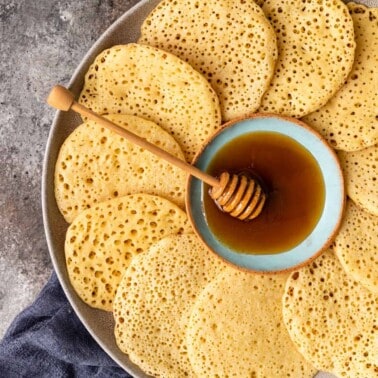

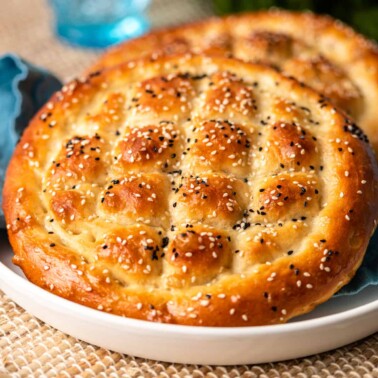








amazing web and very inspiring, your recipes very trust worthy.
im a professional chef,i have been cooking over 28 years, by reading your recipes i can tell how much love you put in it
Thanks so much Moeen!
I’ve tried your Simit recipe (loved it) and the Turkish Pide rounds, so soft and delicious, but when I tried this recipe for lavash I threw away my mother-in-laws reciep that I’ve used forever. Thanks for showing me tastier and easier ways to make these classic breads Kevin.
Always glad to be of assistance and grateful to read what you’ve tried others, and took the time to come back and comment on, Beth. Cheers!
I’m struggling to follow this recipe I don’t see any of the comments address it. Maybe I’m overlooking a step? It calls for 1 1/2 cups of warm water. For the yeast paste you use half cup of water. There are no instructions on where to add the other full cup of water. I started adding it to my dough and toy quickly was too thin after adding just half a cup., Please advise.
Sorry for any confusion Connie! It goes with Step 2: In the bowl of a stand mixer combine the remaining 3 cups flour, water, salt, oil, and the yeast paste. Hope this helps.
I can eat this Armenian flat bread with every meal! It’s AMAZING!!
I couldn’t agree more Beti. It’s so versatile!
This Armenian flat bread was such a special treat!! We loved, LOVED it! YUM!
Its so easy to make, too. Thanks Katerina. 🙂
Its not Armenian its Azerbaijani!
Davud, the recipe was adapted from the cookbook “Lavash” by Kate Leahy, John Lee, and Ara Zada. “Lavash: The bread that launched 1,000 meals, plus salads, stews, and other recipes from Armenia (Armenian Cookbook, Armenian Food Recipes)”. Realizing Azerbaizan is Armenia’s neighbor, they might have been mistaken? Not sure, but thanks for the information. I’d be interested in your information to back up your claim?
Please start investigating – this is important. Azerbaijans history by looking at what the people in your land area were before the Muslims erased the history and renamed the streets, towns and cities. They destroyed thousand year old katchkars, churches and monasteries to fulfill their desire to create a region that never existed before the 1800s. Why do you think your Azerbaijani food resembles our Armenian cuisine from thousands of years? It’s because you were all originally Armenians.
Thanks for that clarification and insight Irma. I just like to make delicious food and try my best to do all research prior for authenticity and history.
This bread is the perfect side dish for so many meals!
Exactly, couldn’t agree more Cathy. Especially warm from the oven. 🙂
I had no idea lavash was so simple! It turned out perfect.
So glad I could help Amanda, hope you enjoy these. Perfect hot from the oven!
This looks so delicious and perfect for a side dish! So excited to give this a try!
Thanks Beth! I love the slightly chewy texture when fresh baked!
I sometimes make pita bread at home and always wanted to make lawash then I found your recipes and I followed it exactly , and my lawash turn out amazing so thank you
So happy you tried it and enjoyed Shamy! 🙂
I tried Lavash some time ago and I loved it! It’s so great to make it at home!
Nothing beats fresh from the oven breads, right?! So good and easy to make.
This Armenian Flatbread is seriously making me hungry!
Thanks Erin, it’s such a versatile flatbread. I love this with lebnah and shatta sauce!